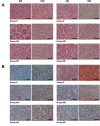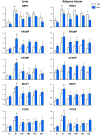Effects of kampo formulas on the progression of hypercholesterolemia and Fatty liver induced by high-cholesterol diet in rats
- PMID: 25901102
- PMCID: PMC4404525
Effects of kampo formulas on the progression of hypercholesterolemia and Fatty liver induced by high-cholesterol diet in rats
Abstract
Background: Bofutsushosan is a well known Kampo, traditional Japanese medicine, based on ancient Chinese medicine mainly used in the treatment of hypercholesterolemia in Japan. We selected two Kampo formulas, Boiogito and Keishibukuryogan mainly used in the treatment of hypercholesterolemia in China to compare with Bofutsushosan and cholesterol absorption inhibitor ezetimibe.
Methods: Hypercholesterolemia and fatty liver were induced by high cholesterol (containing 2% cholesterol and 0.5% cholic acid) diet in male Wistar rats for 6 and 12 weeks. Kampo formulas Boiogito, Bofutsushosan, Keishibukuryogan and ezetimibe were added to the high-cholesterol diet, respectively. After 6 and 12 weeks, body and liver weights, blood chemistry, cholesterol concentrations, fat-related and inflammatory-related factors were examined.
Results: High-cholesterol diet increased body and liver weights, and serum cholesterol concentrations. Boiogito and ezetimibe improved them. Serum ICAM-1 and RBP4 were increased in the high cholesterol diet group. Boiogito and ezetimibe improved them too. In the histological examinations of liver and adipose tissues, we observed a significant improvement after treatment. Immunostaining expression of ICAM-1 in aorta was improved by Boiogito, Bofutsushosan, Keishibukuryogan and ezetimibe. The mRNA expression of RBP4, HFABP, CFABP, MCP1 and CCR2 in liver and adipose tissue were decreased by Boiogito and ezetimibe.
Conclusion: Boiogito has a protective effect on the progression of hypercholesterolemia and fatty liver induced by high-cholesterol diet in rats and more effective than Bofutsushosan and Keishibukuryogan. The lipid-lowering effect of Boiogito is not stronger than ezetimibe. But the anti-inflammatory (MCP1, CCR2) and anti-arteriosclerotic (ICAM-1) effects of Boiogito are more potent than ezetimibe.
Keywords: Bofutsushosan; Boiogito; Keishibukuryogan; fatty liver; hypercholesterolemia.
Figures





Similar articles
-
Components of Boiogito Suppress the Progression of Hypercholesterolemia and Fatty Liver Induced by High-Cholesterol Diet in Rats.Yonago Acta Med. 2016 Mar;59(1):67-80. Epub 2016 Apr 1. Yonago Acta Med. 2016. PMID: 27046953 Free PMC article.
-
Boiogito, a Kampo medicine, improves hydrarthrosis in a rat model of knee osteoarthritis.BMC Complement Altern Med. 2015 Dec 24;15:451. doi: 10.1186/s12906-015-0979-7. BMC Complement Altern Med. 2015. PMID: 26703073 Free PMC article.
-
Ezetimibe improves high fat and cholesterol diet-induced non-alcoholic fatty liver disease in mice.Eur J Pharmacol. 2008 Apr 14;584(1):118-24. doi: 10.1016/j.ejphar.2008.01.045. Epub 2008 Feb 12. Eur J Pharmacol. 2008. PMID: 18329014
-
[An inhibitor of intestinal cholesterol transporter].Nihon Rinsho. 2013 Sep;71(9):1661-6. Nihon Rinsho. 2013. PMID: 24205731 Review. Japanese.
-
A Review on the Mechanism and Application of Keishibukuryogan.Front Nutr. 2021 Dec 24;8:760918. doi: 10.3389/fnut.2021.760918. eCollection 2021. Front Nutr. 2021. PMID: 35004802 Free PMC article. Review.
Cited by
-
The Multiple Pharmacologic Functions and Mechanisms of Action of Guizhi Fuling Formulation.Evid Based Complement Alternat Med. 2022 Apr 29;2022:6813421. doi: 10.1155/2022/6813421. eCollection 2022. Evid Based Complement Alternat Med. 2022. PMID: 35529925 Free PMC article. Review.
-
Exploring the Mechanism of Gyejibokryeong-hwan against Atherosclerosis Using Network Pharmacology and Molecular Docking.Plants (Basel). 2020 Dec 10;9(12):1750. doi: 10.3390/plants9121750. Plants (Basel). 2020. PMID: 33321972 Free PMC article.
-
Ameliorative effect of bofutsushosan (Fangfengtongshengsan) extract on the progression of aging-induced obesity.J Nat Med. 2024 Jun;78(3):576-589. doi: 10.1007/s11418-024-01803-4. Epub 2024 Apr 25. J Nat Med. 2024. PMID: 38662301 Free PMC article.
-
Components of Boiogito Suppress the Progression of Hypercholesterolemia and Fatty Liver Induced by High-Cholesterol Diet in Rats.Yonago Acta Med. 2016 Mar;59(1):67-80. Epub 2016 Apr 1. Yonago Acta Med. 2016. PMID: 27046953 Free PMC article.
-
A simple method for inducing nonalcoholic steatohepatitis with fibrosis.Animal Model Exp Med. 2019 Nov 14;2(4):282-290. doi: 10.1002/ame2.12089. eCollection 2019 Dec. Animal Model Exp Med. 2019. PMID: 31942560 Free PMC article.
References
-
- Roffi M , Brandle M , Robbins MA , Mukherjee D . Current perspectives on coronary revascularization in the diabetic patient. Indian Heart J. 2007; 59: 124-36. . - PubMed
-
- Angulo P , Lindor KD . Non-alcoholic fatty liver disease. J Gastroenterol Hepatol. 2002; 17Suppl: S186-90. . - PubMed
-
- Marchesini G , Moscatiello S , Di Domizio S , Forlani G . Obesity-associated liver disease. J Clin Endocrinol Metab. 2008; 93 (11Suppl 1): S74-80. . - PubMed
-
- Targher G , Marra F , Marchesini G . Increased risk of cardiovascular disease in non-alcoholic fatty liver disease: causal effect or epiphenomenon?. Diabetologia. 2008; 51: 1947-53. . - PubMed
LinkOut - more resources
Full Text Sources
Miscellaneous
